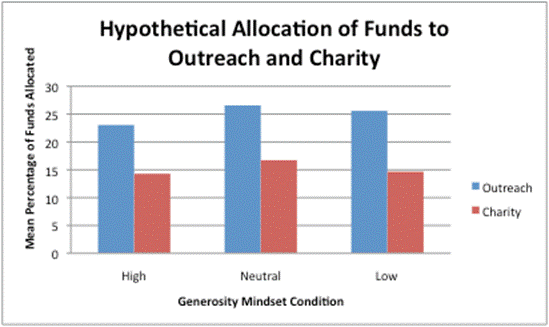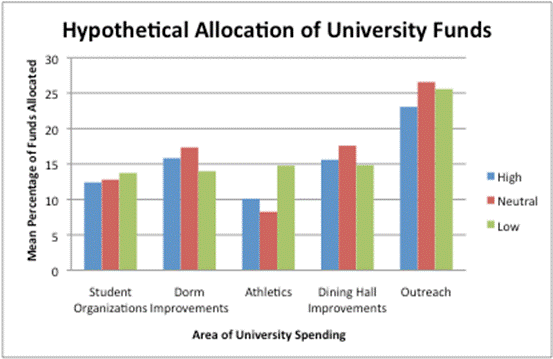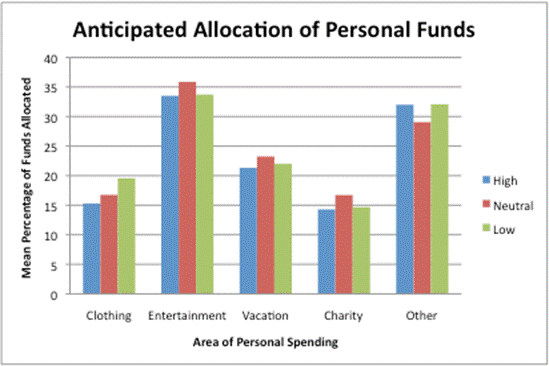Do Perceived Social Norms Affect Generosity?
Matthew Hagler, Catherine Lambert, Natalie Rothwell, and Karen Yu*
Sewanee: The University of the South
Key words: social norms, generosity, mindset
Abstract
Generosity, defined as one’s willingness to give, has been studied in a variety of contexts. The present study sought to uncover the effect of perceived social norms on generosity. Undergraduate students completed an electronic questionnaire supposedly examining community engagement. We exposed participants to one of three different social norms for generosity by embedding different statistics regarding the behavior of the average undergraduate student within the questionnaire. Following this manipulation were two evaluative questions measuring generosity via participants’ allocation of funds to outreach and charity, followed by an abbreviated version of the Interpersonal Generosity Scale (IGS). The provided social norms did not affect participants’ allocation of funds to outreach and charity. Alternative interpretations of these results are discussed, including the possibilities that: (a) social norms influence generosity only when both the provided social norms and the assessment of generosity refer to the same specific act, (b) our manipulation of social norms was not strong enough, and (c) our measure of generosity was not sensitive enough, given that we assessed participants’ hypothetical allocations to two broad categories.
Introduction
Generosity, simply defined as willingness to give, is a subject of great interest to psychologists. With the media frequently broadcasting the misfortune of others and the wide publicity of charities, people today have greater pressure, greater opportunity, and, some might argue, greater responsibility to give. What factors affect generosity or willingness to give? Investigations of this question could have beneficial practical applications to marketers for charities, educators, and parents.
Previous research supports a relationship between mood and generosity. Underwood (1977) measured the generosity of moviegoers after seeing a sad or neutral movie, finding that sadness has a significant negative effect on generosity. In another study with Froming and Moore, Underwood (1977) manipulated the mood of children through reminiscence. Similarly, they found that children in the neutral mood condition were more generous than the children in the sadness condition, and children in the happiness condition were more generous than children in both of the other conditions.
A considerable amount of previous research has focused on the effect of reinforcement on altruism. Rushton and Teachman (1978) compared the effects of positive reinforcement and punishment on subsequent generosity relative to a neutral condition. Compared to those in the neutral condition, children who had been positively reinforced displayed greater generosity, and children who had been punished displayed less generosity. Moreover, Masters and Pisarowicz (1975) found that second graders’ generosity was greater when positive reinforcement was contingent upon generosity than when it was non-contingent upon generosity.
In a recent study, Croson, Handy, and Shang (2009) examined how perceived social norms affect subsequent giving behavior. The first part of their study was purely correlational; they sent a questionnaire asking about perceptions of “normal” giving behavior to individuals who had previously donated to a radio station. They found a significant positive correlation between perceived norms of giving behavior and actual giving behavior. People gave more when they felt that others gave a larger amount. The second part of their study was experimental; they presented undergraduates with a hypothetical situation, including a high or low social norm, and asked how much they would give. Participants presented with the higher social norm said they would contribute significantly more than did participants presented with the lower social norm, suggesting that social norms influence individuals’ giving behavior in a hypothetical situation.
The present study seeks to extend the findings of Croson et al. (2009) and contribute to our understanding of the relationship between social norms and generosity using a more general context. Like Croson et al., we experimentally manipulated participants’ perception of social norms and measured subsequent generosity. We presented different social norms as statistics within a questionnaire supposedly measuring undergraduate outreach participation. Whereas Croson et al. presented participants with a social norm for giving to a public radio station and examined the effects on giving to that same radio station, we attempted to alter participants’ general mindset about generosity by presenting social norms for a variety of different forms of generosity (e.g., volunteer work, donating money, donating blood) and measuring subsequent generosity in a completely unrelated context.
Based on previous literature, particularly the work of Croson et al. (2009), we predict that participants exposed to high social norms will indicate greater social generosity than those exposed to a neutral condition (in which no social norms are offered) or to low social norms.
Method
Participants
The potential participants consisted of the entire undergraduate student body of a small, private liberal arts university in Tennessee. A total of 170 participants completed the study.
Materials
The researchers constructed a questionnaire that manipulated social norms of generosity via the first nine questions. Each of these questions first provided a statistic (fabricated by the researchers) stating the average undergraduate participation in a particular activity that displays generosity (e.g., giving blood, donating to charity, completing community service) and then asked participants to rate their own participation in the activity on a Likert scale. One version of the questionnaire (High) contained statistics indicating a high average undergraduate participation in these activities, another version (Low) contained statistics indicating low average undergraduate participation in these activities, and another (Neutral) provided no statistics whatsoever, with participants simply asked to rate their participation in comparison to the average undergraduate.
Following these manipulation questions were two evaluative questions intended to measure participants’ generosity. The first evaluative question informed the participants that their school had a budget surplus and asked them what percentage of the funds they would allocate to each of the following: student organizations, the outreach office, dorm improvements, athletics, and dining hall improvements. In the second evaluative question, participants were asked what percentage of their own income next year would go to each of the following: clothing, entertainment, charity, vacation, and other. In particular, we were interested in the percentage of funds participants allocated to the outreach office (in evaluative question #1) and to charity (in evaluative question #2); because funds allocated to the outreach office and to charity do not directly benefit participants, these were considered as indicators of generosity.
As another measure of generosity, an abbreviated version of the Interpersonal Generosity Scale (IGS; Smith & Hill, 2009) followed the evaluative questions. The IGS consists of a series of statements related to interpersonal generosity; participants rate how well each statement describes them on a Likert scale.
Following the IGS were demographic questions regarding gender, age, and class year. Participants were also asked whether they belonged to a Greek organization, whether they received merit or need-based financial aid, and whether they participated in a varsity, club, or intramural sport.
The last question of the questionnaire was included as a manipulation check. It asked the participants to rank their perception of the statistics provided in the first nine questions as low, moderate, or high. The manipulation check question was not asked of participants in the neutral condition because no statistics were provided in that condition.
Procedure
We administered our questionnaires electronically via Survey Monkey (http://www.surveymonkey.com). An e-mail message was sent out to the entire undergraduate student body asking them to complete a questionnaire for a study on community engagement at the university. Assignment of students to experimental conditions was achieved by dividing an alphabetized list of all student e-mail addresses into thirds; each of the resulting groups was randomly assigned to a given experimental condition. Each group’s e-mail included a hyperlink to the appropriate version of the questionnaire (Low, High, or Neutral social norms).
Results
Of primary interest are (a) participants’ hypothetical allocation of institutional funds to outreach activities and (b) participants’ anticipated allocation of personal funds to charity. Figure 1 shows the percentage of funds participants allocated to the outreach office and to charity. A MANOVA indicates no significant relationship between condition and allocation of funds to outreach [F(2,146) = .744, p = .477] or to charity [F(2,146) = 1.206, p = .303].
Figure 1. Percentage of funds allocated to the Outreach Office (Evaluative Question 1) and Charity (Evaluative Question 2) by participants in each condition.Figures 2 and 3 show the participants’ allocations of institutional funds (Figure 2) and of personal funds (Figure 3) across the options given. There was a significant effect of condition on the percentage of funds allocated to athletics, with participants in the Low condition allotting significantly more money to athletics than participants in the Neutral and High conditions [F(2, 146) = 4.115, p = 0.018].
Figure 2. Percentage of funds allocated to each area of spending when participants in each condition were asked to distribute a $10,000 surplus in their university’s budget (Evaluative Question 1).
Figure 3. Percentage of funds allocated to each area of spending when participants in each condition were asked how they would spend their income over the next year (Evaluative Question 2).Table 1 shows the data from the manipulation check question. Comparing the High and Low conditions, more participants in the High condition rated the provided statistics as “High,” and more participants in the Low condition rated the statistics as “Low.” In both conditions, the majority of participants rated the statistics as “Moderate.” There was a significant difference in the distribution of responses for participants in the high and low conditions X2 (2, N = 170) = 36.09, p < 0.001.
Table 1
Manipulation Check: Percentage of Participants in the High and Low Conditions Rating the Provided Statistics as Low, Moderate, or High
Perception of Statistics Provided
Condition
Low
Moderate
High
High
3.30%
55.00%
41.70%
Low
33.30%
64.90%
1.80%
Discussion
Our manipulation of perceived social norms did not affect the allocation of funds by participants to (a) outreach activities or (b) charity. Thus, our hypothesis was not supported. This may indicate that social norms provided for a variety of generous acts do not affect generosity with regard to a different act—i.e., it may be that social norms affect generosity only when both refer to the same specific act. Alternatively, there may in fact be a broader effect of social norms on generosity that our study simply failed to measure. Indeed, there are certain characteristics of the present study that must be considered in interpreting the similarity of results across social norm conditions.
Our manipulation check indicates a significant difference in participants’ ratings of the statistics by which we sought to manipulate perceived social norms, with more participants in the High condition classifying the presented statistics as “High” and more participants in the Low condition classifying them as “Low.” However, in both conditions the modal response labeled the statistics “Moderate.” It is possible, then, that our manipulation of perceived social norms was not strong enough to reveal an effect on generosity.
The measurements of generosity in the evaluative questions were intentionally broad and nonspecific. We did not want participants to be explicitly aware that their generosity was being measured, so we measured it based on the allocation of funds to broad, nonspecific organizations (i.e. “outreach” and “charity”) rather than specific, more tangible areas of generosity. Perhaps the breadth and non-specificity of these terms yielded measurements less sensitive to possible effects of social norms on generosity. Indeed, perhaps participants’ allocations to these two categories are not a particularly good measure of generosity. This might be the case if, for example, participants do not perceive allocations to the outreach office or to charity as generous acts, if other aspects of the outreach office or charity overshadow any sense of associated generosity, or if the other possible recipients of funds constrain participants’ allocations in a manner we did not anticipate.
Furthermore, the operational definition of generosity we used was, again, intentionally broad. Our manipulations of perceived generosity (presented as statistics of undergraduate participation in a variety of charitable activities) and the evaluative measurements of generosity (monetary allocations to outreach and charity) were quite unrelated. Rather than having the manipulation and measurement refer to the same generous behavior, as did Croson et al. (2009), we sought to tap into a more general manifestation of generosity. Our data may indicate that the influence of social norms is context-specific, wherein provided social norms have an effect only if they refer to the same generous behavior. Alternatively, perhaps the norms we provided did not differ enough across conditions to yield a differential effect on generosity (recall that for both the Low and High conditions, the majority of participants rated the provided statistics as “moderate”).
Moreover, our questions asked participants to anticipate their behavior in hypothetical or future situations. When people give, they often receive a feeling of pride and/or satisfaction that they have made a difference and done something good for somebody else. Hypothetically allocating funds to “outreach” and “charity” does not come with these rewards for giving. As such, the evaluative questions may underestimate the true generosity of participants. More broadly, participants’ responses to hypothetical situations may not accurately reflect how participants would actually behave in such a situation.
Obviously, there is room for a continuation of research in this subject area. Previous studies demonstrating significant differences were quite specific, manipulating and measuring generosity in the same context. This study used a broader definition of generosity, seeking to determine whether one might instantiate a broad generosity mindset by presenting social norms for a variety of activities. Yet this breadth may have led to less sensitive measures. We encourage further investigation of these issues. Determining whether a broad generosity mindset influences specific acts of generosity has implications for a number of areas, from the way in which charities present data and raise funds to how parents and educators instill generosity in children.
References
Croson, R., Handy, F., Shang, J. (2009). Keeping up with the Joneses: The relationship of perceived descriptive social norms, social information, and charitable giving. Nonprofit Management & Leadership, 19(4) 467-489. doi:10.1002/nml.232.
Masters, J. C., & Pisarowicz, P. A. (1975). Self-reinforcement and generosity following two types of altruistic behavior. Child Development, 46(2), 313-318. doi:10.2307/1128123
Rushton, J., & Teachman, G. (1978). The effects of positive reinforcement, attributions, and punishment on model induced altruism in children. Personality and Social Psychology Bulletin, 4(2), 322-325. doi:10.1177/014616727800400232
Smith, C., & Hill, J.P. (2009). Toward the measurement of interpersonal generosity (IG): An IG scale conceptualized, tested, and validated. Unpublished monograph. University of Notre Dame. Retrieved from http://generosityresearch.nd.edu/assets/13798/ig_paper_smith_hill_rev.pdf
Underwood, B. (1977). Attention, negative affect, and altruism: An ecological validation. Personality and Social Psychology Bulletin, 3(1), 54-58. doi:10.1177/014616727600300106
Underwood, B., Froming, W. J., & Moore, B. S. (1977). Mood, attention, and altruism: A search for mediating variables. Developmental Psychology, 13(5), 541-542. doi:10.1037/0012-1649.13.5.541
|


